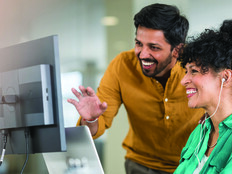Standard Telework Tech Would Need a Boost for Congress
The proposed legislation does not specify what kind of technology would be needed for remote congressional voting. Portman’s proposal, for example, leaves those decisions up to the Senate sergeant of arms and the secretary of the Senate, and on the House side, the clerk, the chief administrative officer and the sergeant at arms.
“Many members and congressional staff use applications on our official devices that use two- or three-factor authentications in order to securely verify their identity. Voting remotely could be similar,” Rep. Vicente Gonzalez, D-Texas, writes in The Hill. “Be it a fingerprint, face scan, or an RSA token, the technology exists.”
The House does use an electronic system to count roll-call votes, but members still must be physically present in Washington to insert a special card into a device that records their votes — it cannot be done remotely, or by another person.
Staff has had the means to work from home for years, and those employed by members who are in quarantine or self-isolation are doing so. It’s still an unusual experience, however, for teams whose primary job is to have contact with constituents, to travel with their bosses and to cluster in crowded hallways and meeting rooms during hearings and votes.
“The technology is in place to support much of the work that goes on in the background at the staff level,” Frederick Hill, a managing director at FTI Consulting and a former congressional staffer, tells TechCrunch. “They have VPN networks, shared drives for offsite work, devices and smartphones to keep them in contact and help draft legislation.”
Many VPNs, however, are not built to handle the volume and duration of connections they’re being asked to with so many people working from home, says Bill Harrod, federal CTO at MobileIron, which counts congressional offices and campaigns among its customers.
Typically, VPN use is sporadic and short — an employee opens a VPN, does his or her work and logs out of the VPN. “We now have this enormous number of employees and contractors connecting to VPNs, and they remain up for days on end,” Harrod tells FedTech. “Traditional network VPNs are not tuned for that.”
MORE FROM FEDTECH: Learn how agencies can cope with the strain on their networks.
Security Remains an Issue for Remote Voting
The U.S. House of Representatives Committee on Rules issued a report on March 23 on voting options during the pandemic, noting much the same. “Security and reliability are hallmarks of the current system and any divergence from current practices must retain the same level of integrity,” according to the report.
“Although off-the-shelf products exist to allow a Member to videoconference their vote, for example, they have not been tested under the sort of pressure they would face from enemy states or other bad actors trying to force the system offline or prevent individual Members from accessing it,” the report continues. “Such a system has to be extensively tested, not used for the first time on must-pass legislation.”
Individually, the pieces of a remote voting system do exist, including multifactor authentication, videoconferencing, secure connections, encryption, biometrics and endpoint security, Harrod says. “But tying that in with a way of being able to actually then cast the vote, those technology pieces have not been put together,” he adds.
“From the voting standpoint, there is really no application in use today or readily available that would provide us with the appropriate level of strong authentication to know that somebody who cast a vote was actually the elected official.”
Some Congressional Members Encourage Distance Voting
Representatives who have had COVID-19 tell The Washington Post that finding a way to work remotely was imperative. “We have to look at other ways to carry on our business,” says Rep. Joe Cunningham, D-S.C., 37, who was able to recover from the virus at home.
Rep. Mario Diaz-Balart, R-Fla., 58, who quarantined himself in a separate location from his high-risk wife during his illness, told the Post that a full return to Washington is “the last thing you want.”
But even if the technology was ready, remote voting isn’t something that can happen immediately.
“A rule change of this magnitude would also be one of the biggest rule changes in the last century, in one of the most critical institutions in our country,” writes the Committee on Rules in its report, which was requested by House Speaker Nancy Pelosi, age 80.
Neither Pelosi nor Senate Majority Leader Mitch McConnell, age 78, favor remote voting at this time. “We will deal with the social distancing issue without fundamentally changing Senate rules,” McConnell told reporters on March 17.
Ironically, reports the McClatchy Washington bureau, “each of the leading proposals for remote voting that has been formally introduced on both sides of the Capitol would require members to be in Washington, D.C., to vote to change the rules to allow future remote voting.”











